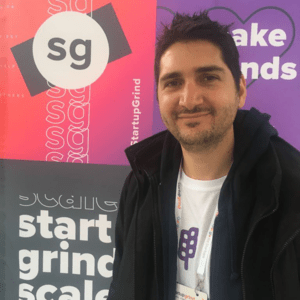Helping software products with their product and growth strategies. Pushing businesses forward with data-backed decision-making, rigor, and strategic moves. An advocate for product-led growth and customer-centric lean development.
Improving your marketing and product strategy with data
About this episode
In this episode, Vahe Baghdasaryan and Kritika Jalan talked about the differences between marketing led-growth and product-led growth. You’ll also hear about the role of data in designing well-performing growth strategies and marketing campaigns. They also discussed the common pitfalls that companies make while using data in their strategy, and the tool-sets you need to build efficient marketing and growth strategies.
What they talked about:
- How marketing led-growth differs from product led-growth
- The significance of data in designing winning product growth strategies
- Common mistakes in utilizing data in your campaigns and strategies
- Challenges faced due to the lack of quality data
- Tools to design and implement growth strategies
Transcript
Kritika Jalan: Hi people! I’m Kritika Jalan, the GrowthMentor host for today’s podcast. I have been into all things data for a decade now, and have been helping startups at all stages with their data and analytics needs. I also work with Foti and the team here at GrowthMentor and some members. My current love is product and growth analytics. And that is what we are going to talk about here today. Our topic for discussion is data driven product growth. And we have Vahe from CoinStats today to talk about it. Hi, hey, how are you doing?
Vahe Baghdasaryan: Hi Kritika. Thanks for having having me. It’s very wonderful to be here. I’m feeling good. How about you?
Kritika Jalan: Oh, I’m feeling lovely. Where you’re speaking from? I’m speaking from India.
Vahe Baghdasaryan: I’m currently in Yerevan, Armenia connected. Yeah.
Kritika Jalan: That’s great. I think you’re closer to me than I am closer to Europe. So that that’s nice.
Vahe Baghdasaryan: Yeah, I lived there. There’s only like two hours of difference.
Kritika Jalan: Yeah, yeah. Such things happen. I’m glad. All right. Oh, do you want to jump right into it?
Vahe Baghdasaryan: Yeah, sure. Let’s.
Kritika Jalan: Okay. I would let you first. Talk a little bit about yourself. Introduce yourself to our audience today.
Vahe Baghdasaryan: Yeah, sure, sure. Basically, my first my first job in marketing was as a digital marketing specialist at one of the local marketing agencies, where we worked with several local and international clients and we provided them social media services and digital marketing services. And then I started to work with different startups from Silicon Valley to Moscow, helping them with mainly pages, their acquisition and influencer marketing. And then I joined SoloLearn as a product marketing manager. And SoloLearn is the words that are just called learning platform on mobile, I was working on a new product launches, positioning of the new features, adoption and everything in between. And the meantime, I was advising this new promising Ukraine based startup called EduDo, they are building this Tik Tok of educational content. And I’m helping them to find their product market fit and start their first growth initiatives. And the last year I joined CoinStat as a senior growth marketing manager, and CoinStat is a crypto portfolio management platform, like mean for crypto basically. And my main focus here is on engagement and monetization activities and responsible for lifecycle marketing, and building engagement and monetization strategies.
Kritika Jalan: Cool, that’s a lot. Thanks for this. This got curious, so from the very first job title, like you mentioned, a lot of them seemed into marketing, all growth, wanted to understand how did you end up in growth? And what excites you about it every day?
Vahe Baghdasaryan: Yeah. So as I mentioned, I started my career at the like digital as a digital marketing agency as a digital marketer. And then I started to work with like different startups from like different countries. And I liked the process. I like how I like the process. I like working with them. And then I started I started to get no growth. I was reading a bunch of articles and I was taking courses. I remember that I have been reading Andrew Chan’s blog, like every day to learn about growth strategies and this matrix, like everything in between. And then I started to apply what I learned in the startup that I working with and it and everything. And then everything starts to work for me. And then I got I offered the job from SoloLearn as a product marketing manager and joined them and my main issue initially, and I was there as I said, I was working on a product launches, positioning of the features and driving adoption. Yeah. And then yeah, and then I joined finally CoinStats last year as a growth marketing manager and started to apply growth full stake, and in areas such as engagement and monetization.
Kritika Jalan: It really intrigues me every time someone uses full stack with other setups, right. So I come from beta and I was just having a discussion with a colleague of mine a few days back, and she mentioned something like, oh, so people like us are called full stack data people like, oh, okay, that’s interesting. And you mentioned something very similar around growth. So I was wondering if you can elaborate for our audience on how does product lead growth and marketing lead groups differ? And what your current role at CoinStats looks like from both of these perspectives?
Vahe Baghdasaryan: Yeah, sure, sure. So like when we’re talking about product lead growth, it’s essential to understand that the foundations of product lead growth are the acquisition activation, engagement and monetization. On the other side marketing, lead growth companies care much, much more about user acquisition, and then and barely invest in user activation or engagement. So the other thing is that product lead growth companies are more cost efficient, like product lead growth spent a big chunk of their revenue or new user acquisition. However, like the product lead growth, companies create these self sustainable growth loops that ensure the growth of the company in terms of revenue or new user acquisition, so they don’t need to invest heavily in paid user acquisition or something. And the other thing is that product lead growth companies usually have lower customer acquisition cost compared to marketing lead growth. This is because like PLG companies have a lot of organic growth channels such as SEO ASO. And marketing lead, put more effort into paid user acquisition that overtime drives the acquisition costs way too higher. And that this is like one of the differentiators of product lead growth companies for marketing lead growth company. So talking about CoinStats, I believe we are currently in the middle. But we are like going more everyday, we are going more towards becoming a fully product lead growth company. But currently, I’d say we are somewhere in between. And yeah, pulling in like a lot of initiatives to become fully functioning product lead growth company.
Kritika Jalan: So, also what you mentioned, I got really intrigued that I was thinking can both of these models run together where marketing lead growth, then feeds into product lead growth? But like you mentioned, yeah, companies might start as one then diverge into both of them and then probably then just go with say something like a product lead growth. And I think that is something like an organization where this is happening.
Vahe Baghdasaryan: Yeah, yeah. Yeah. I believe so. Yeah. Because we are, I mean, we are but actually we are more like product lead growth company than marketing lead growth company. And we are like, yeah, increasing our initiatives in terms of becoming a fully product lead growth company.
Kritika Jalan: Right. Okay. I forgot to ask, just for the sake of our audience, can you talk a little bit about what CoinStats is about?
Vahe Baghdasaryan: Yeah, sure. So CoinStats as the crypto Portfolio Manager platform. It’s like when you have different exchanges or wallets where you invest crypto, you need one place to see all the picture of your investments. And there it comes CoinStats, like you connect all your exchange and wallet accounts to CoinStats . And you say the whole financial picture of your investments, how much profit you make, how much you lose? And everything in between? So we are kinda like mean for crypto if you know mean for like banks and credit cards, we are doing the like crypto investment management for people.
Kritika Jalan: Yeah, this is extremely interesting. I was just at lunch today we were just talking all things crypto. And this is like, Oh, we coming back to the same topic.
Vahe Baghdasaryan: Yeah. You also can connect your NF T’s to CoinStats to see how much you’re making on them or like losing so yeah.
Kritika Jalan: Yeah, that’s interesting. I think I will be the one that goes and looks at it. First thing. Okay. Going back to the product lead growth. I wanted to understand when you mentioned a few times about growth strategies and growth loops. Wanted to know how do how does your in my domain come together into the picture? So how big is the role of data in designing product product lead growth strategies?
Vahe Baghdasaryan: Yeah. So when you’re working in growth, I believe that data should be your best friend. You know, I’m confident to say that data plays one of the most crucial roles in designing growth strategies. Yeah, so you can’t you can’t launch a new, let’s say, lifecycle marketing campaign, or a promotional campaign or make improvements in your onboarding flow without having a good data, infrastructure and data analysis. You know, I mean, to elaborate here more, let’s take this simple example. You know, let’s imagine it’s Black Friday, and you’ve launched your traditional Black Friday promotion campaign, and you don’t have any data interval. And you don’t have any data and starts infrastructures or analysis. And you made, let’s say, 40,000 in sales. So what happens here? The many people just say, you know, as a result of our campaign, the company made 40,000 in sales. But this arises a lot of questions. First of all, like, Did you maintain a holdout group before sending your campaign or not? Because you’re going to need to compare these are the results of the users who got the campaign to the result from your holdout group, right. And it’s, it’s so understand how many sales you could have without the promotion campaign. Moreover, if you see that there are like 10,000 cells from your holdout group users, your original number is wrong, then it’s not 40,000. And you also need to track cancellations and refunds. Without data try without without tracking and proper data infrastructure, you can’t, you’re not able to track the cancellations or refunds. I mean, if let’s say you got another 10,000 in refunds, and cancellations, so no, you’re now your original number is much, much lower. So it’s very important to have our like proper tracking and data infrastructures that helps you to track the real important, the real impact of your campaign, you know, and this is this was like, very simple example of not having a proper data system, in the heart in the heart of your growth initiatives. Without data, everything you can do, can be misleading and cause much, much bigger headaches in the future. And, you know, and the other thing is that some companies actually try to implement some methodologies to analyze the impact of their campaigns or strategies. But some of them get do it in the wrong way. You know, again, I mean, let’s take the example of intent to treat and a methodologist. I’m sure you know it. And, you know, many, many companies use this methodology to measure the impact of the initiatives they do. But however, like most of them are getting this wrong. For example, you’ve launched a trial to pay the nudging, like lifecycle campaign that aims to increase the conversion rate from trial to paid. And you maintained your holdout group and decided to use the intent to treat methodology to analyze the impact. So when analyzing the campaign’s impact, some people only start comparing the conversion rate from the people who opened the emails or push notifications to the holdout groups conversion rate. So they ignore all users from the test group who didn’t open the email or push notification, and only take those who opened or God God got exposed. This is very wrong thing to do. And that leads to selection bias because it helps it to show some uplift. But it doesn’t show the overall impact of your lifecycle campaign. If you if you want to see the real impact of your initiative, you should compare the entire test group, the whole holdout group, you know, I mean, this are some basic things that are happening to a lot of companies, because they don’t they don’t put data first on their initiatives, or they try to implement some day to some methodologies to analyze their initiatives or putting some tracking or infrastructures, but they’re getting the trunk. So I mean, I believe that every time when you when you want to send out a campaign, or make some changes, experiments, you need to put data first, because as I said before, data is your best friend, and it’s not going to lead and he’s going to help you to bring much much bigger impact.
Kritika Jalan: Yeah, I feel you and I’ve been in the middle of data and won’t goodbye multiple companies. And it happens more often than not when there are experiments running, which are either not well designed or not well measured afterwards. And then you see, somehow all the experiments that the group’s team has been doing, they’ve all been showing great success on numbers. And one very big factor is like, we all know that almost 70% of experiments fail. And so instead of looking at them as a failure, if we just look at them as a learning, because no experiment is a failed experiment, you learn from both the experiment times. And so if you pick the learning, and then you know, re iterate on your experimentation space with that, there’s so much more progress that you can do so much more quickly, only if you look at the numbers in the right way, as well. So very good point that you mentioned that make data your friend then go from there.
Vahe Baghdasaryan: Yeah, like, yeah, when you do experiments, yeah, you don’t have failed, you know, I believe, like, my approach to experiments is either you succeed, succeed, or you learn, you know, and you use your learnings you need to, like use your learnings to design more meaningful experiments that have more chances to succeed. You don’t need you don’t need, you don’t need to look your experiments only as a success or fail, you need to learn it. Otherwise, you need to learn from them.
Kritika Jalan: Yeah, and a lot of times it so happens is when that you want to be doing all of that. But you probably don’t have the right data, or you don’t have the right tracking, or the data is just not enough. So wanted to understand if there are any challenges similar to this that you face at contact to lack of data or lack of quality data?
Vahe Baghdasaryan: Yeah, so I mean, I believe that almost all companies face challenges due to the lack of data or quality data, at CoinStats, I’m proud to say that we invest heavily in data engineering to build proper and well functioning data infrastructures and a system and to be able to get good, good quality data. And we use two leading platforms for analysis. One of them is amplitude, we use amplitude for product analysis. And we also use Appsflyer for attribution, and for a few other things. So yeah, but I mean, we faced many challenges when we, when there was noise in the data that didn’t, that didn’t allow us to effectively track the impact of experimentations, or some campaigns. But still, yeah, we invest heavily in data and storage infrastructures. And our goal is to have this well functioning data system that has no noise in it, and allows us to test our experiments, launch campaigns and analyze them in a proper way to grow for verte.
Kritika Jalan: Yeah, and then. So you mentioned a few things around how you work with data and the experiment. So you mentioned amplitude as well. Can you talk about how does your staff look like in terms of tools? And then what kinds of techniques you use to help with the growth strategies like activation, retention, etc?
Vahe Baghdasaryan: Yeah, yeah, sure. So you, I mean, you have to have good analytics and CRM tools first of all right? Do you need them to design impactful activation and engagement campaigns, it would be best to have like well functioning CRM that allows you to build workflows plus campaigns, this multi channel campaigns and everything in between very small play, and an analytics tool to have this holistic view of your campaigns. Because it’s not always about conversion. The the holistic approach allows you to see the other side of your campaigns and other like additional benefits that your campaign drives. So for analytics, as I say, like I love to work with amplitude, they have this this segmentation tool that allows you to show to get the choice or the paths and journeys of your users. And they have this funnel analysis that helps you to identify the drop offs on your funnel, or to see conversion or conversion rates from x to y, and for CRM, lifecycle marketing purposes I love. I love using Iterable to design my life cycle marketing campaigns it was it has a like very engaging experience and help you build this multi channel campaigns very smoothly. And the best is if you can integrate these two platforms, each other, your CRM and analytics tools, in my case, they’re a trouble and amplitude, it allows to see, as I mentioned, the holistic view of your campaigns, right? Because let’s take this example, you are launching this lifecycle marketing campaign that a lot that aims to excuse me, and you’re launching this lifecycle marketing campaign and you want to drive the conversion of the users. The convert, you want to drive the conversion of the users who connect their portfolios to CoinStats, let’s say in our case, and you and your success metric is the portfolio connection conversion rate is when the user connects crypto exchange your wallet to CoinStats. And when you have this analytics tool, let’s say the amplitude, it allows you to see the holistic view of your campaign, not only how much conversion your campaign drives, but also the retention of the users who got your campaign. It can be that your campaign drives like lower conversion rates, bad the users who got the campaign shows like higher retention rates in day one or week one. So it allows you to like see more broader picture, and have much learn much more learnings to be able to create to improve your campaigns and make them more powerful and impactful.
Kritika Jalan: Yeah, that that sounds like yeah, the stats that you mentioned. And in terms of CRM tools, other than I think that you mentioned, I’ve seen a brace to be used, as well, one signal and analytics tool, specifically, apart from magnitude, the other product analytics tool would be Mixpanel, that really helps you with this as well. So one last thing, just for the benefit of our listeners, if you had to, you know, give your entire experimentation process, for example. So if you have a CRM campaign that you have to run tomorrow, what are things? Like, how does the process look like right from idea generation to at the end, saying whether this was a failed experiment or a successful one?
Vahe Baghdasaryan: Yeah, so first of all, I mean, every campaign starts from brainstorming the ideation, you know, we are having this. We are starting to brainstorm around areas that we want to drive impact. And we want to we start, like brainstorming what kind of campaigns we can can launch to be able to drive, let’s say the conversion rate in different areas. For example. Let’s take our example again, we launched this new feature, called CoinStats wallet, it’s our crypto wallet, that if if you don’t have a wallet, and you want to start investment, you can sign up, create your own coins that wallet and start investing. So and we want to have more users to create coins, thoughts, wallets. So that’s the goal. And we start brainstorming around this idea, like what kind of campaigns we can launch. And when we are like writing down several ideas, picking some of the few of them that can be potential campaigns. Some of them can be like always on lifecycle campaigns. Some of them can be one time, like in app messages or short push notification campaign or whatever. And we start experimenting with them, we are putting this as I said, for CRM, we use Iterable. And Iterable allows you to do this A B testing very smoothly, you can have like, you can test like this to push notification very easily or multiple subject lines on your email or everything you can basically a B test very, very easily. And this is for optimizing like copy subject lines, wherever and we start like building the workflows, you know We build, we build the workflows on launch the campaigns, and then we analyze the results. And based on the results, we decide to kill the campaign or not. And sometimes we kill campaign sometimes, based on the learnings we make improvements on the on the workflows are real launch again, and that drives a higher conversion rates. So we try to our approach is to, like, test everything and learn from the mistakes or insights and use your learnings to improve the campaigns improve the workflows that you’re sending out, to get more higher results to higher your conversion rates and the other metrics that you are tracking.
Kritika Jalan: This was absolutely helpful. Thanks a lot Vahe. Any last thoughts? Or ending note or advice for the listeners?
Vahe Baghdasaryan: Yeah, I mean, out go ahead, I can give the same advice that I said earlier, make data your friend, especially if you are working in growth, and you need to unit to be good with data because it got it’s gonna allow you to reach I mean, it’s gonna allow you to build like more impactful campaigns do more impactful changes, try make your experiments more proper. It kind of had to to do experimental experimentations properly and everything in between. So that’s my biggest advice to everyone who is working on growth.
Kritika Jalan: I think we aligned here make data your friend. Yeah. Go on the path of growth. Alright. Thanks a lot for taking the time to talk with us today. And I’ll see you around.
Vahe Baghdasaryan: Yeah, thanks. Thanks for having me. Yeah.
In this episode


I’m a Product and Growth Marketing Manager, having experience on working in consumer startups. I can help you in defining and analyzing your retention, setting up activation and engagement strategies as well as churn prediction and resurrection. So, just sign up and let’s talk!
Join the community
Enjoy the peace of mind that advice is always only one Zoom call away.




